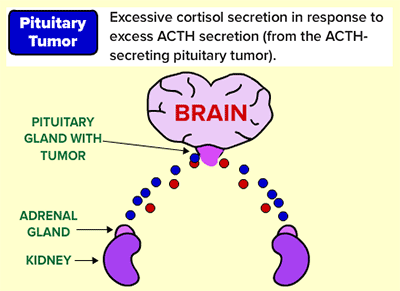Cushing’s Syndrome: Classifying the Type
Adrenal or Pituitary Cushing’s? Why do we Care?
Once a pet has been confirmed as having Cushing’s syndrome, the next step is to determine which form of Cushing’s syndrome the pet has since treatment and prognosis are different for each form. As described, there are two forms, commonly abbreviated PDH and AT. PDH stands for pituitary dependent hyperadrenocorticism and accounts for 85 percent of canine and feline Cushing’s patients. In PDH, there is a pituitary tumor, often extremely small, causing over stimulation of the adrenal glands. AT simply stands for adrenal tumor. Adrenal tumors can be benign or malignant. Testing to determine the type or form of Cushing’s disease is called discriminatory testing. This type of testing is done AFTER the diagnosis of Cushing’s disease has already been made. Here are some issues and concerns where the type of Cushing’s disease the pet has becomes an important matter.
- If there is an adrenal tumor, there is a 50 percent chance that it is malignant. It is helpful to know if the pet has a condition with this kind of a malignancy rate, especially if surgery is being considered.
- If the patient is known to have an adrenal tumor, this knowledge will direct the doctor on how and where to look for tumor spread to determine if the patient has cancer or not. On the other hand, if the patient is known to have a pituitary tumor, it becomes more relevant to image the brain to look for evidence of pressure on the brain.
- Medication protocols may be very different for adrenal tumors versus pituitary tumors.
- Surgery protocols are completely different for adrenal tumors versus pituitary tumors.
Approximately 85 percent of Cushing’s patients will have pituitary dependent disease while approximately 15 percent will have adrenal tumors. This statistic appears to be valid in dogs as well as cats.
Dogs
What Tests will Tell us What Type of Cushing’s Syndrome the Dog Has?
The Low Dose Dexamathasone Suppression Test
If you are lucky, the same test used to determine if a pet has Cushing’s disease can also classify the Cushing’s disease so that no further tests are needed. To get the information needed, a 4-hour sample is drawn in addition to the pre-dexamethasone sample and the 8-hour sample. If the cortisol level suppresses to a level below 50% of baseline at 4 hours, only to escape to a level high enough to indicate a positive result, only a pituitary tumor is possible.

While pituitary tumors do not always show this kind of classic suppression at four hours, adrenal tumors never do. If suppression is seen in the 4-hour sample, further testing is not needed, though this is the only pattern that is distinctive enough to obviate further testing. Approximately, 60 percent of patients with pituitary tumors can be identified with the low dose dexamethasone suppression test.
The High Dose Dexamethasone Suppression Test
This test is similar to the low dose dexamethasone suppression test except that a higher dose of dexamethasone is used and the patient has already been diagnosed with Cushing’s. The idea behind is that a patient with a pituitary tumor will show suppression in circulating cortisol when exposed to the high dose of dexamethasone; suppression does not occur with the low dose. If there is an adrenal tumor, suppression does not occur. Unfortunately, the theory does not hold well enough to make this a reliable test; a full 20 to 30 percent of pituitary tumors will fail to suppress even with the high dose of dexamethasone. Furthermore, this test cannot identify patients with adrenal tumors; it is able to confirm about 70 to 80 percent of patients with pituitary disease. The rest will need further testing.
Endogenous ACTH Level
Many veterinarians feel this is the most accurate method of classifying Cushing’s syndrome, but the problem is that the test is technically challenging to run. Serum from the patient must be frozen when transported to the laboratory and must not thaw. The hormone ACTH is fragile and may not survive the trip to the lab. The idea with this test is that a patient with a pituitary tumor will have high ACTH levels, as this is what the tumor is secreting. A patient with low or no measurable ACTH levels has an adrenal tumor as the pituitary is trying its best not to stimulate the over-active adrenal tumor.
Imaging
Fundamental to discerning pituitary dependent from adrenal tumor is the size and shape of the adrenal glands. With pituitary dependent disease, both adrenal glands are being over stimulated so they should both be symmetrical in size and shape and most likely enlarged. With an adrenal tumor, one gland will be severely atrophied and possibly undetectable, while the other is enlarged and possibly misshapen. This difference makes imaging of the adrenal glands an accurate way to distinguish types of Cushing’s syndrome. Ultrasound, MRI, or CT scan can be used, however, ultrasound is the most readily available and least costly. In one study, ultrasound was able to correctly identify adrenal tumors in 86 percent of cases. Sedation is generally not needed for abdominal ultrasound, whereas CT and MRI require general anesthesia and usually needs referral to a specialty clinic.
An added benefit of imaging includes looking for evidence of malignancy should an adrenal tumor be identified. Malignant tumors tend to invade the vena cava, the largest vein in the body. Ultrasound has been found to be extremely accurate in evaluating for this complication. Imaging also allows for taking measurements of the adrenal glands. Glands that measure greater than 4 cm in length are highly suspicious of being malignant.
It is important to note that ultrasound can never be used to make the initial diagnosis of Cushing’s syndrome as there is too much variability in the size of normal adrenal glands. When it comes to gaining information, imaging is best used on patients already known to have Cushing’s syndrome for whom classification is needed.
Is it Reasonable to Play the Odds and not do Further Testing?
Since 85 percent of canine patients with Cushing’s have a pituitary tumor, it is not unreasonable to play the odds and treat for a pituitary tumor. The risks in doing so is that if the patient doesn’t readily respond to medication, it will be impossible to know if the dose simply needs adjustment or if the patient has an adrenal tumor and a completely different treatment is needed. A great deal of time and effort could be wasted by pursuing the wrong therapy.
Cats
For a cat with Cushing’s, the methods that can be reliably used to distinguish pituitary from adrenal disease are: high dose dexamethasone suppression testing; endogenous ACTH; and imaging.
High Dose Dexamethasone Suppression Test
The feline high dose dexamethasone suppression test is the same as the canine version except that even higher doses must be used. If the cortisol levels suppress in response to injected dexamethasone, then only a pituitary tumor is possible. If the cortisol levels do not suppress, however, then no conclusion can be drawn as 50 percent of feline pituitary tumors will not suppress. This can be a frustrating situation but since the test is non-invasive, it is worth a try to confirm a pituitary tumor in this way.








